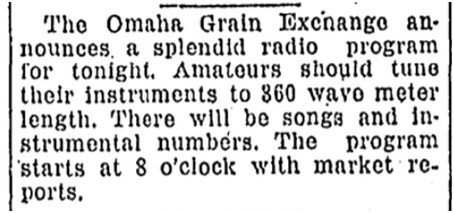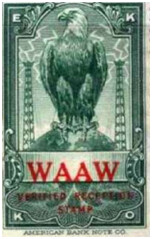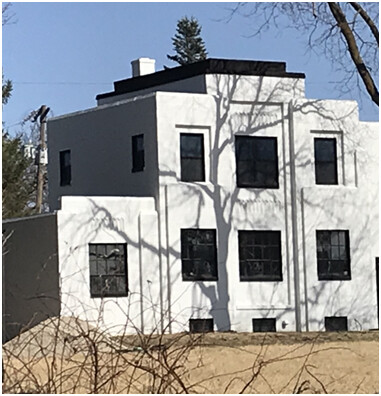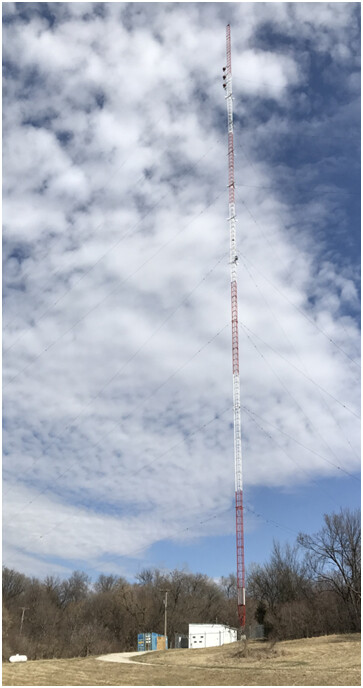Centenary Radio: KCRO – The Oldest in Omaha Hits 100

In this, the 101st anniversary year of commercially licensed broadcasting, we would like to take a look at the oldest living station in the state of Nebraska – currently known as KCRO.
In fact, I had the pleasure of being in the employ of KCRO for 19 years, from 1998-2003 and 2004-2018. Why, it seems only yesterday we celebrated the 90th anniversary!
AT THE GRAIN EXCHANGE
The station currently licensed to 660 kHz in Omaha, Nebraska, got its start a hundred years ago in the Omaha Grain Exchange Building as sequentially assigned WAAW, one of the first of those sequential call letters as evidenced by the two A’s in the middle.
The head of the Grain company heard a small transmitter and instantly realized this was an excellent way to get market reports out to farmers in the mid-west.
As most all stations of the time, it began life at 360 meters, or 833 kc. (you may prefer kc/s or kHz) with 15 Watts, and a flattop antenna, with attached transmitter and studio, atop the Exchange Building. After a few test broadcasts starting in March 1922, the Omaha Grain Exchange and WAAW received its license on April 19, 1922 and officially got on the air right away.

Seated in the studio – on the floor of the exchange – were some 500 people. Another 250 were at the Chamber of Commerce dining room, where a receiver was set up. Still others, perhaps 800 more were scattered at two hotels, the High School, and Ft. Omaha.

reception stamp
It did not take long for farmers and others to respond. Reception was reported as far as Hawai’i and Australia. WAAW took pride in their market reports – every thirty minutes for as much as 25% of the broadcast day.
MOVING AROUND THE DIAL
Once the Department of Commerce (DoC) acknowledged the large number of stations fighting for the one channel, they opened up the AM band and permitted some stations to move around.
Actually, WAAW’s time alone on 830 kc in Omaha did not last too long.
Some parallel history is in order, too. By 1925 Nebraska had at least 5 radio stations that ended up lasting to the present day. The next one after WAAW was WJAG in Norfolk, Nebraska, July 27, 1922, followed by WOAW from the Woodmen of the World Building a couple blocks down the street in Omaha. WOAW later would become WOW until 1999, when its then-owners gave up those golden call letters for a mere format change and became KOMJ, later KXSP. (Hence WJAG is the only one of those three pioneers to retain the historic “W” call sign today.)
Other early stations in Nebraska included KFOR, originally in David City, later moving to Lincoln. KFAB was next, licensed November 8, 1924, to a Lincoln Buick dealership. KFAB would move to Omaha after WWII and become Nebraska’s first full-time 50 kW station. KOIL signed on in 1925 just across the river in Council Bluffs, Iowa. It, too, would later move to Omaha.
As the station competed during the 1920’s, WAAW was found at different times on 1050, 1080, 780, 800, 860, and 680 kc, and ultimately landing on 660 kc. in November 1928. (The station was authorized in September 1922 to broadcast on other wavelengths, such as 485 meters, designated for weather and market broadcasts.)
In 1928, the DoC cemented WAAW’s status as a daytime-only station.
NEW DIGS FOR THE TRANSMITTER
In the very early 1930’s the owners of WAAW decided to build a new transmitter site out of town.
FCC history cards indicate this site was licensed in 1931 near 60th and Girard north of the city. This new “state of the art” site was used until 1948.

I recently discovered the building was still standing, though the twin 200-foot towers were long gone. It took a little legwork to verify that this was indeed the former WAAW transmitter site from that period. Eventually confirmation came from a deed search and from a county historical file containing a 1931 Union Pacific Railroad magazine article about the then-new site.
Further confirmation came from the current owner of the building who knew way more about its history and its owners in the interim than I would have expected. The building had been remodeled into an apartment previously, added on to, and again remodeled in the past year. Amazingly, efforts were taken to preserve the character of the exterior, complete with an Art-Deco design added to the main entrance around the back.
CHANGING HANDS, BUT NOT MORE HOURS
WAAW was put on the market by the grain company a time or two in the 30’s before eventually being sold to the Omaha World-Herald.
The paper changed the call letters to KOWH – to match the newspaper owner. In time, the station would gain much greater fame under the new call letters than any other it subsequently held.
Under World-Herald ownership, shortly the paper applied to the FCC for an upgrade which would have moved the station from being daytime only – which it was from the beginning when it primarily handled farm and agricultural news – to a fulltime directional station on 890 (which would become 920 post-NARBA). This was denied.
Next, the paper applied for a 10 kW upgrade on 660 proposing to move the transmitter several miles to the Southeast. This was also dismissed by the FCC. The second proposal was introduced again after V-E day but was again dismissed.
NEW OWNERS MAJOR CHANGE
The sale of the station in 1949 by the World-Herald to a company headed by Robert and Todd Storz eventually ushered in the most popular period for KOWH.
The Storzs’ company, Mid-Continent Broadcasting Co., experimented with a new format at its stations – the format we now call Top 40 – starting with KOWH. Todd Storz was quite the promoter and built the station’s ratings into the 60% range. While I cannot say for sure, I do not think any other station has ever topped that number in this market. And this was with a daytime-only signal!
I am led to believe that KOWH was the daytime station that first popularized the phrase, “to give the other stations a chance to catch up” in the nightly sign-off announcement. In their case, at least for awhile, it had a kernel of truth to it.
THEN THEY CAUGHT UP!
It did not take long for at least one full-time station to figure out it could beat KOWH at its own game.
With its ratings in a tailspin the station had changed call letters to KMEO (Cameo) by the beginning of 1960 to reflect its new Easy Listening format. This happened a few years after Mid-Continent sold the station to the National Review (then-the National Weekly).
Meanwhile, the Storz family continued their Top 40 success in other markets into the 80’s.
FROM HORIZONTAL TO VERTICAL
In terms of technical history, the flattop antenna at the Girard St transmitter was abandoned in 1948 for a new vertical antenna about ½ mile down 60th Street.
The tower had already been erected for the newspaper’s new FM station, KOAD, so in reverse of the usual order, the AM was added to the FM. In fact, I suspect the tower was built with a view toward adding the AM. (Noteworthy here is the beginning of a requirement by the FCC for filtering to keep down mix products from the nearby 590 site which was closer to this site than the former site and by then already had a vertical antenna like 660 was changing to instead of the flattop.)
That FM station signed off in the 50’s; a sort of descendent of it, KQAL, came on in 1959. This one started life on a downtown tower on top of the Omaha National Bank Building – a kind of throwback to the days of AM station towers being on the roofs of buildings. It was sold to the Review in ‘62 and in 1965 the transmitter was moved from downtown to the 660 tower and the FM became KOWH.
THE CURRENT SITE
Both stations moved to a new 660 tower down the hill a bit in 1968.

Two other stations live there, too. 88.9 FM is the three-bay near the top of the tower, and the detuning skirt is for 1490 which is diplexed in the otherwise too-tall tower (270°).
660 is still broadcast from the same tower, while the FM at 94.1 moved to its own taller tower in 1990.
However, more ownership changes were in store for the descendant of WAAW.
NEW OWNERS, NEW FORMATS
First, the National Review sold it to Starr Broadcasting.
In 1966, KMEO was granted a power increase from 500 to 1000 Watts, for which it had applied in 1949 (sometimes the FCC does take awhile to make a decision!).
Starr later changed the format to country and the calls to KOZN with a nickname of 55 Dozen (12 * 55 = 660), your Country Cousin. After a few years, Starr sold KOZN to the local Reconciliation, Inc., a Black-owned business featuring Omaha natives and sports greats Bob Gibson and Bob Boozer among the owners, which returned the call letters on the AM to KOWH and instituted programming serving primarily Black audiences.
This era was another heyday for KOWH. (The KOZN call letters, by the way, would reappear in Omaha on an expanded band station years later.)
AND MORE NEW OWNERS
As the 70’s came to a close, Reconciliation sold the station to religious broadcaster S&M Broadcasting out of Indianapolis d/b/a RadiOmaha, Inc.
RadiOmaha changed the call letters to KCRO for Christian Radio Omaha. That format has remained in place up to the present, under a few different owners. The transmitter has facility remained largely unchanged from 1968 with the major change being the removal of the FM. New studios opened up when KCRO moved into the vacant studios of the former 1490 KYNN.
In 2001, RadiOmaha sold KCRO to a local company, Eternal Broadcasting, headed by veteran broadcast owners Dick Chapin and Dean Sorenson.
Next, Salem Communications came into play a few years later making a successful offer to buy then-non-commercial 100.7 KGBI early in 2005 and subsequently made a deal to take over KCRO at the same time, later adding KHLP 1420 for Salem’s news-talk format under the calls KOTK. Salem owned and operated all three stations until 2018.
BACK TO LOCAL O&O
The AM stations then went back to local ownership being purchased by Walnut Radio to add to their already owned AM KOMJ 1490.
In the technical realm, some of the more interesting things that happened with KCRO over the years included In 2004, KCRO moved into brand new studios in the Burt Street Professional Building on the west side of Omaha. 1420 moved in with KCRO in 2005. Salem then built new studios in place in 2007 to accommodate its three stations.
The arrangement lasted until the 2018 sale when the studio/office complex was divided into separate quarters for KGBI since it was sold to different owners. Walnut kept the lion’s share of the studio part, changing some studios into offices.
SIGNAL IMPROVEMENTS
KCRO was fortunate to still be on a relatively clear frequency, 660, albeit with still just a daytime authorization.
In 2003, KCRO added nighttime operation at reduced power – 54 Watts – in lieu of post-sunset authority. At times, this nighttime operation was hampered by an IBOC signal from WSCR Chicago on 670. Otherwise, it provided good coverage for car reception. In the same time period, KCRO also had just recently added a new tenant on its tower: a non-commercial FM on 88.9. (The former tenant FM had moved to a taller tower a decade earlier under new owners.) Another AM – KBIM on 1490 – is joining the two stations, diplexing onto the tower.
Today, KCRO operates a BE AM 1A transmitter daytime, but even at 660, as interference to the AM Band grew, the nighttime allotment of 54 Watts is less useful than earlier years.
TRANSLATOR MOVES
In the recent Rulemaking regarding FM translators for AM stations, both 660 and 1490 acquired translators.
Unfortunately, the 660 and 1490 translators were disappointing in their coverage, which turned out to be a problem Walnut could fix. Since 660 has a very wide 2mV/m coverage area, it was possible to move that translator to Lincoln.
That opened up the frequency for 1490’s translator and higher power with a new location to the east. Walnut also acquired the translator for their 1420 station, with good coverage to the west. By simulcasting the programming on 1420 and 1490, along with their translators, those two stations now offer complete FM coverage of the Omaha-Council Bluffs market. The only thing missing is that 660 now does not have a translator in Omaha itself.
So that is 100 years in a nutshell (admittedly a large nutshell) as accurately as I could determine from available records, anecdotes, and personal recollection and experience.
– – –
Mike Shane is the former Chief Engineer and Operations Manager at KCRO. You can contact Mike at somethingorother@cox.net
Click here to sign up for the BDR Newsletter and get notice of when other articles are published.
Return to The BDR Menu

